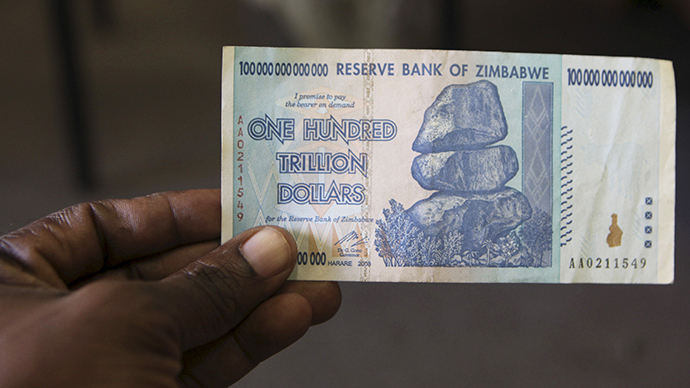Zimbabwe phases out local currency at 35 quadrillion to US$1

Zimbabwe has started retiring its almost worthless local currency in favor of the US dollar. Today, 35 quadrillion Zimbabwean dollars are equal to US $1, as a result of hyperinflation which hit the country in 2009.
The demonetization process of the Zimbabwe dollar started on Monday and will run till September 30.
People with accounts of up to 175 quadrillion (175,000,000,000,000,000) Zimbabwean dollars will be paid $5. Those who preserved bills at home will receive a rate of 250 trillion to $1 for their 2008-issued notes and 250 to $1 for their 2009-issued notes.
Zimbabwe has been using the US dollar since 2009 when the use of the Zimbabwean dollar was abandoned. A multi-currency system has been in operation for the last six years, with the South African rand and US dollar in use since 2009 and the Chinese yuan, Australian dollar, Japanese yen and the Indian rupee joining the list of accepted currencies in 2014. Formally, the national currency was also in circulation although Zimbabwean dollars were marginally used, mostly as souvenirs for their gargantuan denominations.
"We need to safeguard the integrity of the multiple currency system or dollarization in Zimbabwe," John Mangudya, chief of the Reserve Bank of Zimbabwe was cited as saying by Africa Report.
READ MORE: Zimbabwe switches to greenbacks as local currency chalks up the 0’s
"Demonetization is, therefore, critical for policy consistency and for enhancing consumer and business confidence,” he added.
READ MORE: 1 BLN dollars sometimes not enough to buy a scone
Demonetization is an important and necessary process to comply with the multiple currency system, according to the Reserve bank.
In 2008 the monthly inflation rate hit 3.5 million percent with an egg costing 50 billion Zimbabwean dollars. A loaf of bread then cost as much as 12 new cars could have cost 10 years before. Prices doubled every 25 hours, which gave Zimbabwe the second-worst hyperinflation in history, behind post-war Hungary. The same year, Zimbabwe printed its highest denomination banknote, at 100 trillion dollars it was only enough to buy a weekly bus ticket.
Hyperinflation in Zimbabwe gained momentum in 2000 when Robert Mugabe, who has been the country's President since 1987, changed his economic policy and implemented land reform. Mugabe granted farmland owned by white citizens to indigenous black Zimbabweans, who were uneducated and knew nothing about farming. As a result, Zimbabwe turned from an agriculture exporter into an importer, which resulted in 94 percent unemployment and hyperinflation.












